The Influence of Droplet Size and Emulsifiers on the In Vitro Digestive Properties of Bimodal Oil-in-Water Emulsions
Abstract
:1. Introduction
2. Materials and Methods
2.1. Materials
2.2. Preparation of Oil-in-Water Emulsions and Food Emulsion Blend
2.3. In Vitro Gastric and Small Intenstinal Digestion Test
2.4. Measurements and Analysis
2.4.1. Droplet Size Distribution
2.4.2. Microscopic Observation
2.4.3. Zeta Potential
2.4.4. Calculation of Free Fatty Acid Release
2.5. Statistical Analysis
3. Results and Discussion
3.1. Initial Phase
3.1.1. The Characteristics of the Freshly Prepared Emulsions and Food Emulsion Blends
3.1.2. Microstructure of Emulsions and Food Emulsion Blends at Initial Phase
3.2. Gastric Phase
3.2.1. Emulsions and Food Emulsion Blends After Gastric Digestion
3.2.2. Analysis of Droplet Stability During Gastric Digestion
3.3. Small Intenstinal Digestion Phase
3.3.1. Emulsions and Food Emulsion Blends During Small Intestinal Digestion Phase
3.3.2. Analysis of Droplet Stability During Small Intestinal Digestion
3.4. Release of Free Fatty Acids During Small Intestinal Digestion
3.4.1. Secular Changes in Free Fatty Acid Release
3.4.2. Initial Lipid Digestion Rate
3.4.3. Relationship Between Total Droplet Surface Area and Total Free Fatty Acid Release
4. Conclusions
Supplementary Materials
Author Contributions
Funding
Institutional Review Board Statement
Informed Consent Statement
Data Availability Statement
Conflicts of Interest
References
- Golding, M.; Wooster, T.J. The influence of emulsion structure and stability on lipid digestion. Curr. Opin. Colloid Interface Sci. 2010, 15, 90–101. [Google Scholar] [CrossRef]
- McClements, D.J. Food Emulsions: Principles, Practices, and Techniques; CRC Press: Boca Raton, FL, USA, 2015. [Google Scholar]
- van Aken, G.A. Relating food emulsion structure and composition to the way it is processed in the gastrointestinal tract and physiological responses: What are the opportunities? Food Biophys. 2010, 5, 258–283. [Google Scholar] [CrossRef]
- Lee, S.; Jo, K.; Jeong, S.K.C.; Choi, Y.S. Strategies for modulating the lipid digestion of emulsions in the gastrointestinal tract. Crit. Rev. Food Sci. Nutr. 2024, 64, 35–57. [Google Scholar] [CrossRef] [PubMed]
- Acevedo-Fani, A.; Singh, H. Biophysical insights into modulating lipid digestion in food emulsions. Prog. Lipid Res. 2022, 85, 101141. [Google Scholar] [CrossRef] [PubMed]
- Okuro, P.K.; Santos, T.P.; Cunha, R.L. Compositional and structural aspects of hydro- and oleogels: Similarities and specificities from the perspective of digestibility. Trends Food Sci. Technol. 2021, 112, 495–510. [Google Scholar] [CrossRef]
- Tan, Y.; Zhou, H.; McClements, D.J. Application of static in vitro digestion models for assessing the bioaccessibility of hydrophobic bioactives: A review. Trends Food Sci. Technol. 2022, 120, 263–281. [Google Scholar] [CrossRef]
- Salvia-Trujillo, L.; Qian, C.; Martín-Belloso, O.; McClements, D.J. Influence of particle size on lipid digestion and β-carotene bioaccessibility in emulsions and nanoemulsions. Food Chem. 2013, 141, 1472–1480. [Google Scholar] [CrossRef]
- Brennan, J.G. Mixing, emulsification, and size reduction. In Food Processing Handbook, 2nd ed.; Brennan, J.G., Grandison, A.S., Eds.; Wiley: Hoboken, NJ, USA, 2011; pp. 363–406. [Google Scholar] [CrossRef]
- Charcosset, C. Preparation of emulsions and particles by membrane emulsification for the food processing industry. J. Food Eng. 2009, 92, 241–249. [Google Scholar] [CrossRef]
- Khalid, N.; Kobayashi, I.; Neves, M.A. Microchannel emulsification: A promising technique towards encapsulation of functional compounds. Crit. Rev. Food Sci. Nutr. 2018, 58, 630–645. [Google Scholar] [CrossRef]
- McClements, D.J. Critical review of techniques and methodologies for characterization of emulsion stability. Crit. Rev. Food Sci. Nutr. 2007, 47, 611–649. [Google Scholar] [CrossRef]
- Drozłowska, E.; Bartkowiak, A.; Łopusiewicz, Ł. Characterization of flaxseed oil bimodal emulsions prepared with flaxseed oil cake extract applied as a natural emulsifying agent. Polymers 2020, 12, 2207. [Google Scholar] [CrossRef] [PubMed]
- Querol, N.; Barreneche, C.; Cabeza, L.F. Viscosity properties of bimodal bitumen emulsions: New approach. Afinidad. J. Chem. Eng. Theor. Appl. Chem. 2017, 74, 241–246. [Google Scholar]
- Qi, F.; Tanner, R.I. Random close packing and relative viscosity of multimodal suspensions. Rheol. Acta 2012, 51, 289–302. [Google Scholar] [CrossRef]
- Mugabi, J.; Jeong, J.H. Effect of continuous and discontinuous droplet-size distributions on the viscosity of concentrated emulsions in premix membrane emulsification. Ind. Eng. Chem. Res. 2023, 62, 1906–1915. [Google Scholar] [CrossRef]
- Minekus, M.; Alminger, M.; Alvito, P.; Ballance, S.; Bohn, T.O.; Bourlieu, C.; Carrière, F.; Boutrou, R.; Corredig, M.; Dupont, D.; et al. A standardised static in vitro digestion method suitable for food-an international consensus. Food Funct. 2014, 5, 1113–1124. [Google Scholar] [CrossRef]
- Li, Y.; Hu, M.; Xiao, H.; Du, Y.; Decker, E.A.; McClements, D.J. Controlling the functional performance of emulsion-based delivery systems using multi-component biopolymer coatings. Eur. J. Pharm. Biopharm. 2010, 76, 38–47. [Google Scholar] [CrossRef]
- Zangenberg, N.H.; Müllertz, A.; Kristensen, H.G.; Hovgaard, L. A dynamic in vitro lipolysis model: I. Controlling the rate of lipolysis by continuous addition of calcium. Eur. J. Pharm. Sci. 2001, 14, 115–122. [Google Scholar] [CrossRef]
- Wang, Z.; Neves, M.A.; Kobayashi, I.; Uemura, K.; Nakajima, M. Preparation, characterization, and in vitro gastrointestinal digestibility of oil-in-water emulsion-agar gels. Biosci. Biotechnol. Biochem. 2013, 77, 467–474. [Google Scholar] [CrossRef]
- McClements, D.J.; Li, Y. Review of in vitro digestion models for rapid screening of emulsion-based systems. Food Funct. 2010, 1, 32–59. [Google Scholar] [CrossRef]
- Li, Y.; McClements, D.J. New mathematical model for interpreting pH-stat digestion profiles: Impact of lipid droplet characteristics on in vitro digestibility. J. Agric. Food Chem. 2010, 58, 8085–8092. [Google Scholar] [CrossRef]
- Kanda, Y. Investigation of the freely available easy-to-use software ‘EZR’ for medical statistics. Bone Marrow Transplant. 2013, 48, 452–458. [Google Scholar] [CrossRef] [PubMed]
- Perugini, L.; Cinelli, G.; Cofelice, M.; Ceglie, A.; Lopez, F.; Cuomo, F. Effect of the coexistence of sodium caseinate and Tween 20 as stabilizers of food emulsions at acidic pH. Colloids Surf. B Biointerfaces 2018, 168, 163–168. [Google Scholar] [CrossRef] [PubMed]
- Teo, A.; Goh, K.K.; Wen, J.; Oey, I.; Ko, S.; Kwak, H.S.; Lee, S.J. Physicochemical properties of whey protein, lactoferrin and Tween 20 stabilized nano emulsions: Effect of temperature, pH and salt. Food Chem. 2016, 197, 297–306. [Google Scholar] [CrossRef]
- Hur, S.J.; Decker, E.A.; McClements, D.J. Influence of initial emulsifier type on microstructural changes occurring in emulsified lipids during in vitro digestion. Food Chem. 2009, 114, 253–262. [Google Scholar] [CrossRef]
- Mun, S.; Decker, E.A.; McClements, D.J. Effect of molecular weight and degree of deacetylation of chitosan on the formation of oil-in-water emulsions stabilized by surfactant–chitosan membranes. J. Colloid Interface Sci. 2006, 296, 581–590. [Google Scholar] [CrossRef]
- Verkempinck, S.H.; Kyomugasho, C.; Salvia-Trujillo, L.; Denis, S.; Van Loey, A.M.; Hendrickx, M.E.; Grauwet, T. Emulsion stability and interfacial rheology of pectin–Tween 20 mixtures as influenced by pectin chemical structure. Food Hydrocoll. 2018, 85, 144–157. [Google Scholar] [CrossRef]
- Zhang, R.; Zhang, Z.; Zhang, H.; Decker, E.A.; McClements, D.J. Influence of emulsifier type on gastrointestinal fate of oil-in-water emulsions containing anionic dietary fiber (pectin). Food Hydrocoll. 2015, 45, 175–185. [Google Scholar] [CrossRef]
- Schmidt, U.S.; Schütz, L.; Schuchmann, H.P. Interfacial and emulsifying properties of citrus pectin: Interaction of pH, ionic strength and degree of esterification. Food Hydrocoll. 2017, 66, 289–298. [Google Scholar] [CrossRef]
- Park, S.; Mun, S.; Kim, Y.R. Emulsifier dependent in vitro digestion and bioaccessibility of β-carotene loaded in oil-in-water emulsions. Food Biophys. 2018, 13, 250–262. [Google Scholar] [CrossRef]
- Koukoura, E.; Panagiotopoulou, M.; Pavlou, A. In vitro digestion of caseinate and Tween 20 emulsions. Food Biophys. 2019, 14, 120–134. [Google Scholar] [CrossRef]
- Klink, I.M.; Phillips, R.J.; Dungan, S.R. Effect of emulsion drop-size distribution upon coalescence in simple shear flow: A population balance study. J. Colloid Interface Sci. 2011, 357, 543–553. [Google Scholar] [CrossRef] [PubMed]
- Koukoura, S.; Petraki, K.; Kalogeropoulos, K.; Karathanos, V.T.; Mandala, I.G. Effect of emulsifier type and content on the physical properties, stability and in vitro lipid digestion of oil-in-water emulsions. Food Hydrocoll. 2019, 97, 105225. [Google Scholar]
- Tan, Y.; Zhang, Z.; Mundo, J.M.; McClements, D.J. Factors impacting lipid digestion and nutraceutical bioaccessibility assessed by standardized gastrointestinal model (INFOGEST): Emulsifier type. Food Res. Int. 2020, 136, 109372. [Google Scholar] [CrossRef] [PubMed]
- Fredrick, E.; Walstra, P.; Dewettinck, K. Factors governing partial coalescence in oil-in-water emulsions. Adv. Colloid Interface Sci. 2010, 153, 30–42. [Google Scholar] [CrossRef]
- Guo, Y.; Cai, Z.; Xie, Y.; Ma, A.; Zhang, H. Synthesis, physicochemical properties, and health aspects of structured lipids: A review. Compr. Rev. Food Sci. Food Saf. 2020, 19, 759–800. [Google Scholar] [CrossRef]
- Wei, R.; Zhao, S.; Zhang, L.; Feng, L.; Zhao, C.; An, Q. Upper digestion fate of citrus pectin-stabilized emulsion: An interfacial behavior perspective. Carbohydr. Polym. 2021, 273, 118537. [Google Scholar] [CrossRef]
- Changwatchai, T. Molecular Distillation for Separation of Fatty Acids and Triglycerides. Ph.D. Thesis, University of Tsukuba, Tsukuba, Japan, March 2022. [Google Scholar]
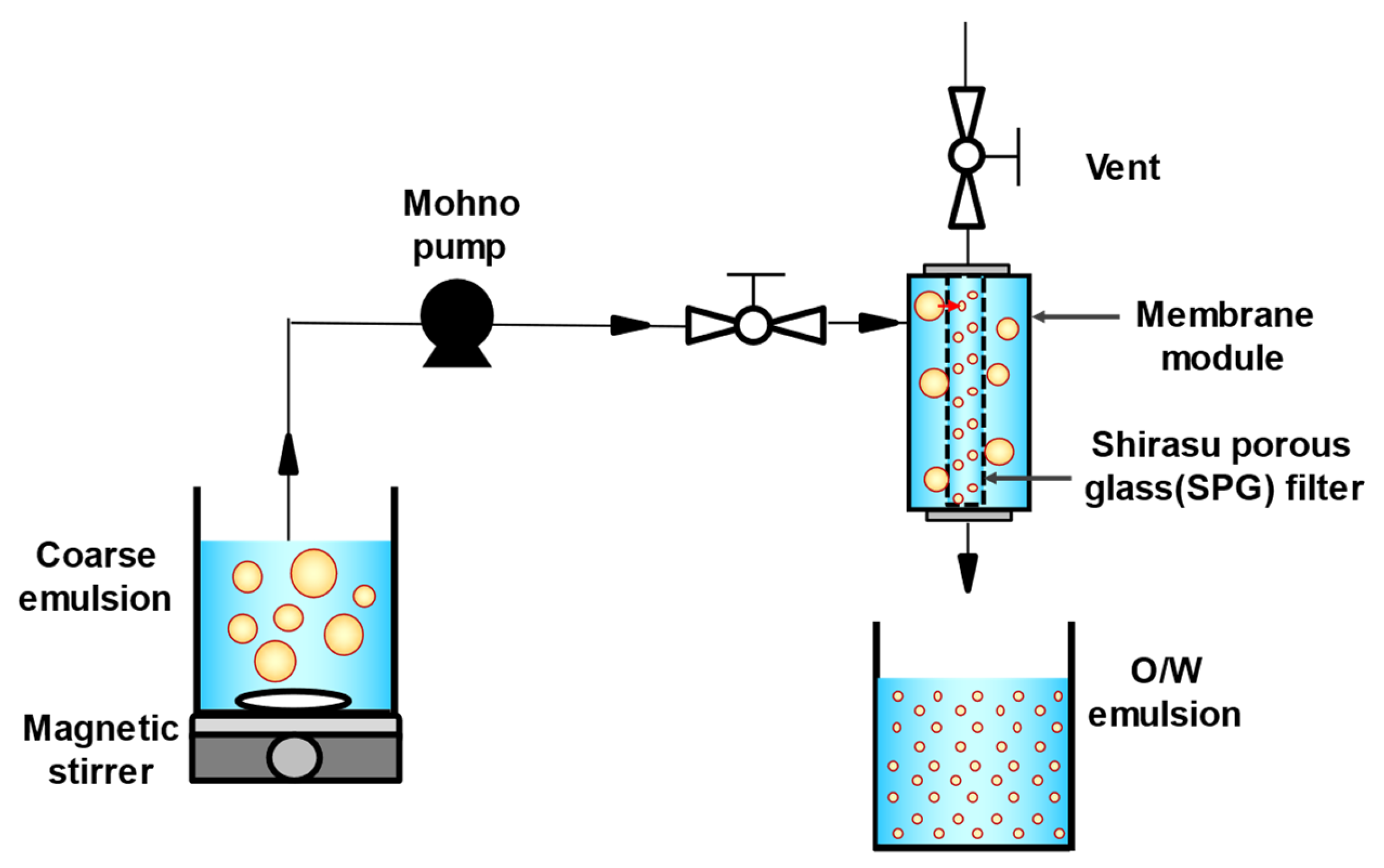
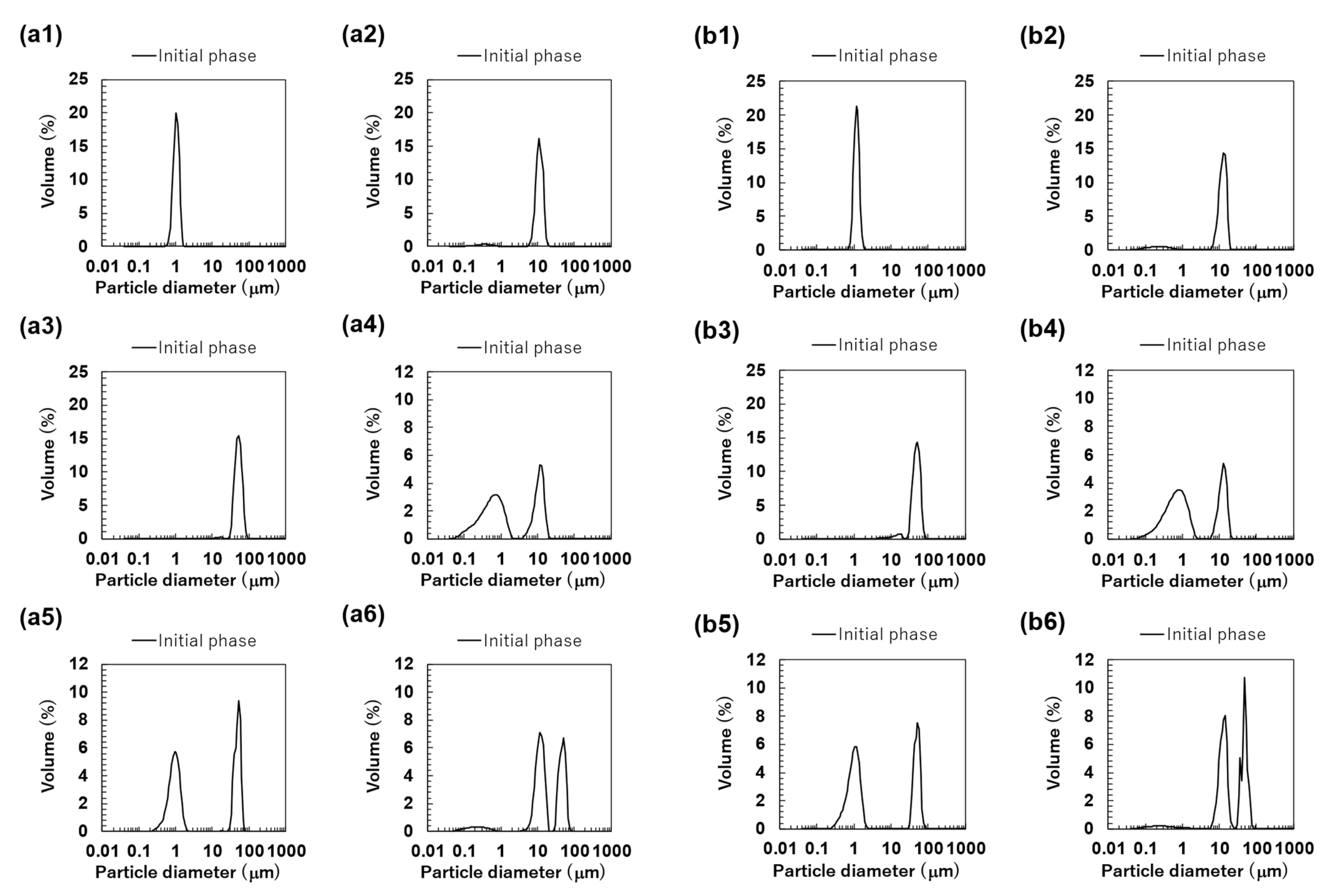


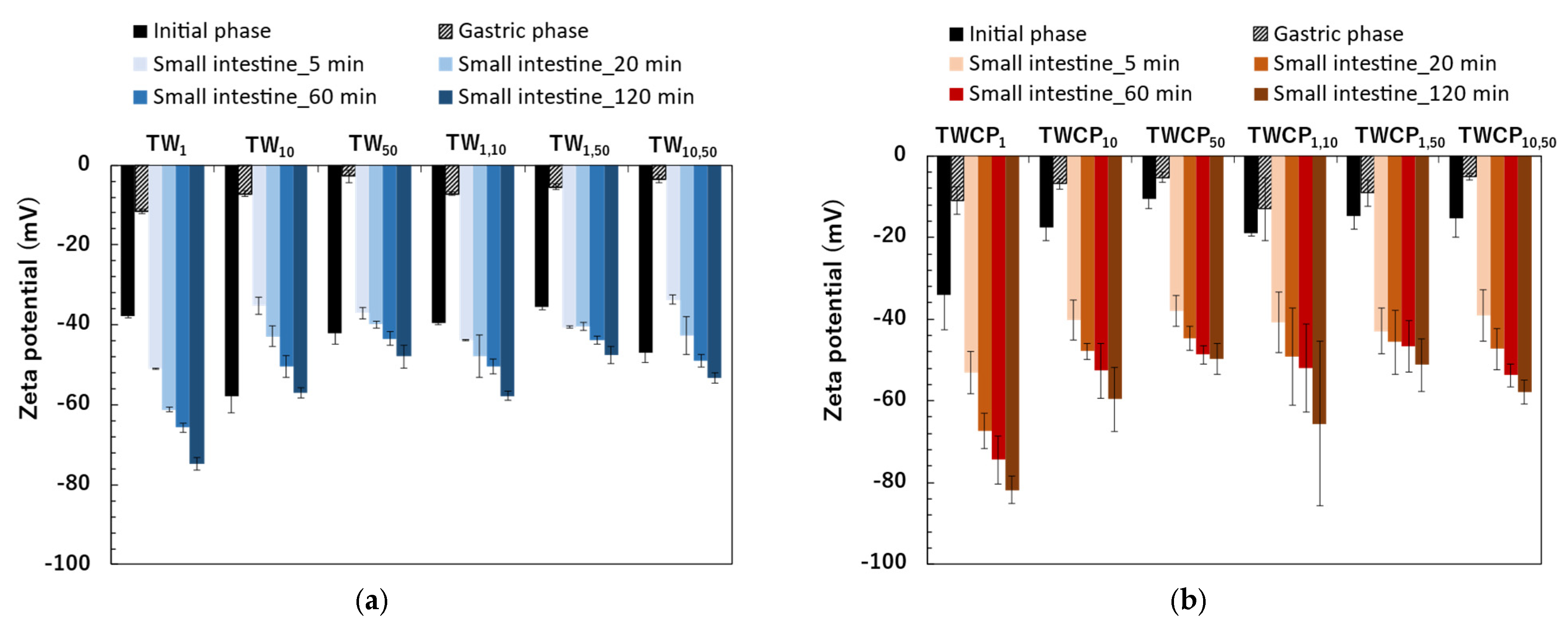


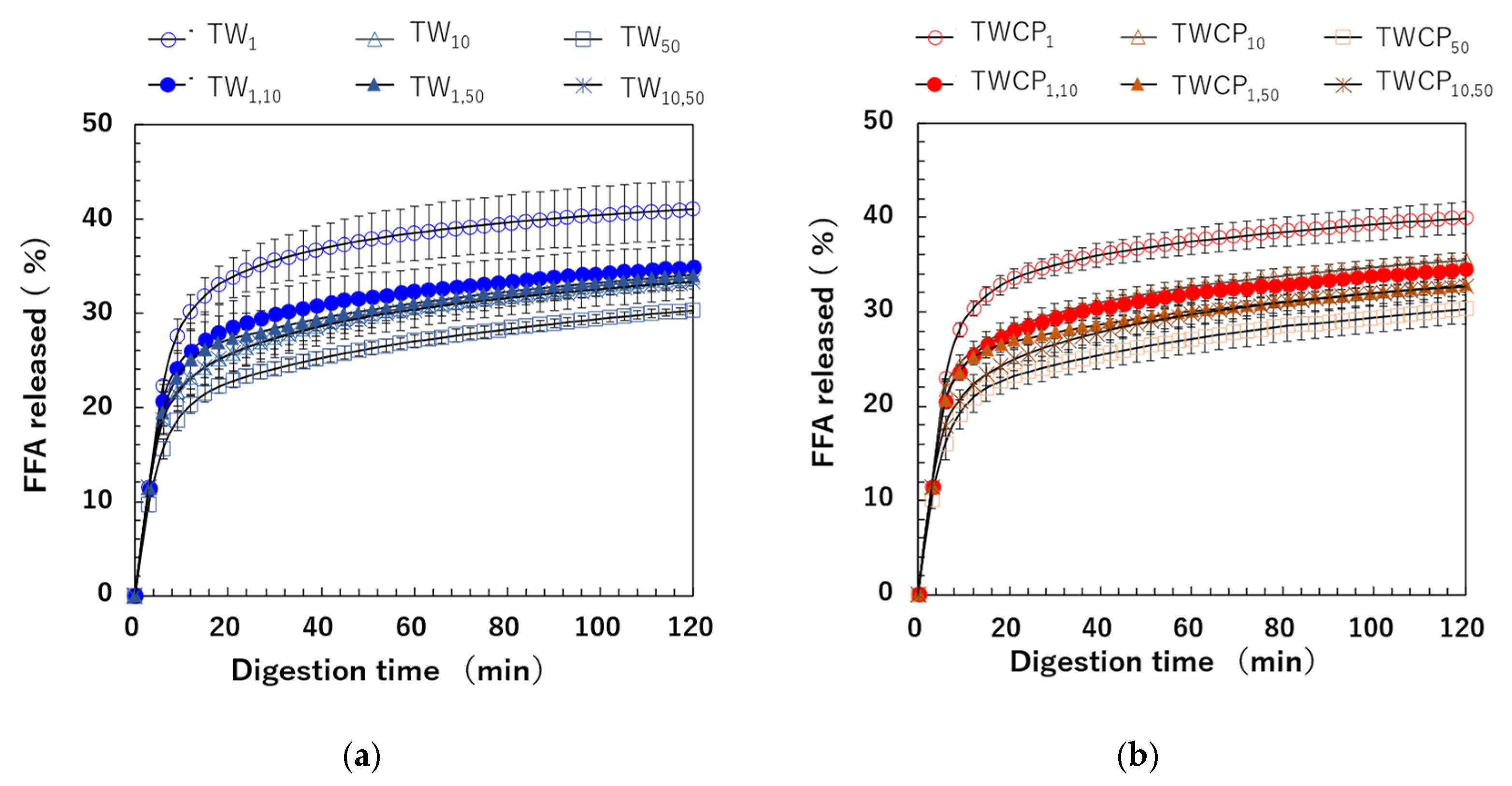
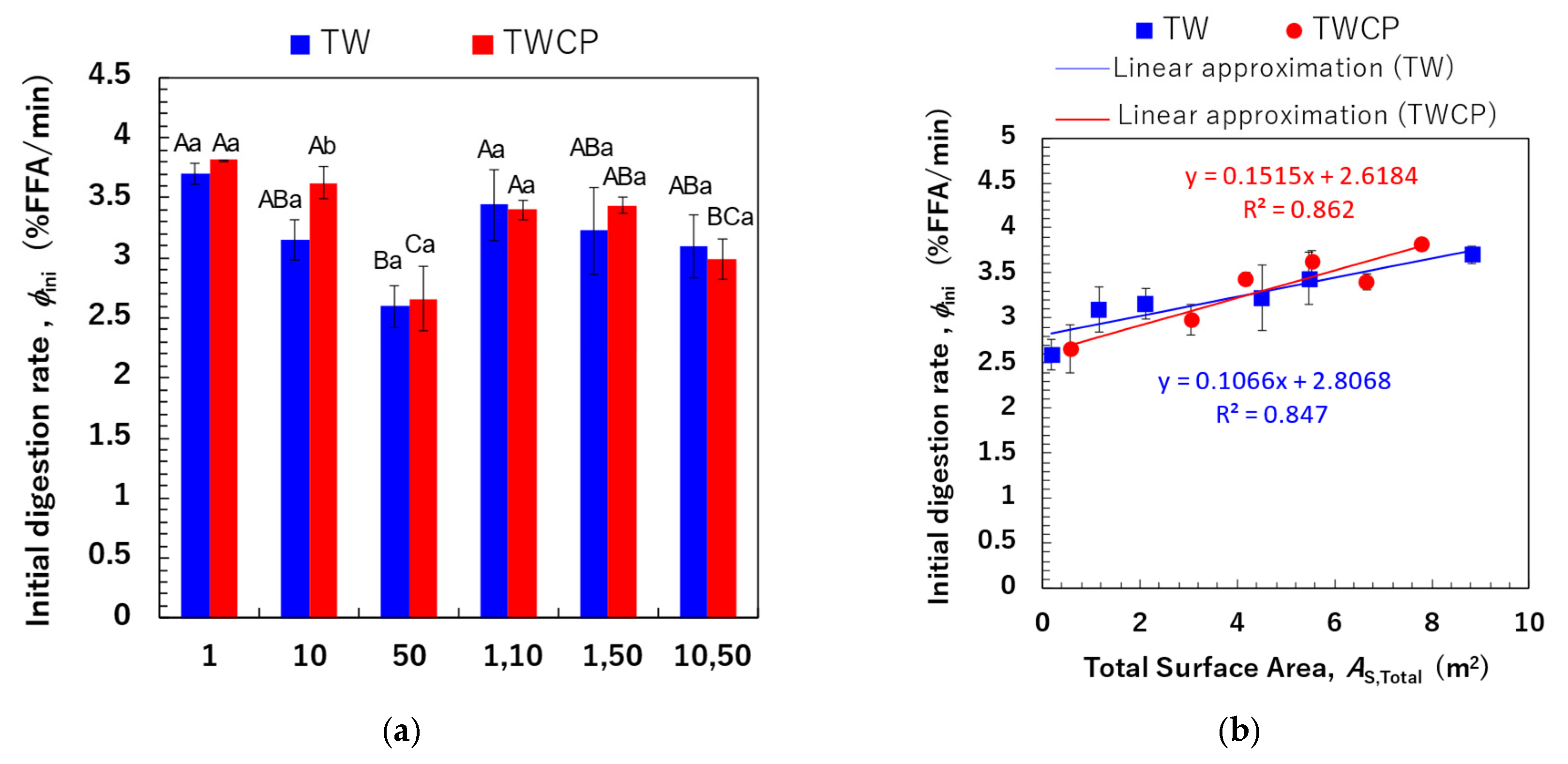

| Continuous Phase | Dispersed Phase | Membrane Pore Size | |
|---|---|---|---|
| TW1 | 1.0% (w/w) Tween 20 (TW) | 10% (v/v) soybean oil | 1 μm |
| TW10 | 10 μm | ||
| TW50 | 50 μm | ||
| TW1,10 | 1 μm, 10 μm | ||
| TW1,50 | 1 μm, 50 μm | ||
| TW10,50 | 10 μm, 50 μm | ||
| TWCP1 | 0.5% (w/w) Tween 20, 0.5% (w/w) citrus pectin (TWCP) | 10% (v/v) soybean oil | 1 μm |
| TWCP10 | 10 μm | ||
| TWCP50 | 50 μm | ||
| TWCP1,10 | 1 μm, 10 μm | ||
| TWCP1,50 | 1 μm, 50 μm | ||
| TWCP10,50 | 10 μm, 50 μm |
| Simulated Gastric Fluid | Simulated Small Intestinal Fluid | ||||
|---|---|---|---|---|---|
| KCl | 0.514 | g/L | CaCl2(H2O)2 | 2.9 | g/L |
| KH2PO4 | 0.122 | g/L | Sodium taurodeoxycholate | 5 | g/L |
| NaHCO3 | 2.1 | g/L | Lipase * | 2000 | U/mL |
| NaCl | 2.76 | g/L | |||
| MgCl2(H2O)6 | 0.02 | g/L | |||
| (NH4)2CO3 | 0.074 | g/L | |||
| CaCl2(H2O)2 * | 0.022 | g/L | |||
| HCl | 49.8 | mM | |||
| Pepsin * | 4000 | U/mL | |||
Disclaimer/Publisher’s Note: The statements, opinions and data contained in all publications are solely those of the individual author(s) and contributor(s) and not of MDPI and/or the editor(s). MDPI and/or the editor(s) disclaim responsibility for any injury to people or property resulting from any ideas, methods, instructions or products referred to in the content. |
© 2025 by the authors. Licensee MDPI, Basel, Switzerland. This article is an open access article distributed under the terms and conditions of the Creative Commons Attribution (CC BY) license (https://creativecommons.org/licenses/by/4.0/).
Share and Cite
Umeda, T.; Kozu, H.; Kobayashi, I. The Influence of Droplet Size and Emulsifiers on the In Vitro Digestive Properties of Bimodal Oil-in-Water Emulsions. Foods 2025, 14, 1239. https://doi.org/10.3390/foods14071239
Umeda T, Kozu H, Kobayashi I. The Influence of Droplet Size and Emulsifiers on the In Vitro Digestive Properties of Bimodal Oil-in-Water Emulsions. Foods. 2025; 14(7):1239. https://doi.org/10.3390/foods14071239
Chicago/Turabian StyleUmeda, Takumi, Hiroyuki Kozu, and Isao Kobayashi. 2025. "The Influence of Droplet Size and Emulsifiers on the In Vitro Digestive Properties of Bimodal Oil-in-Water Emulsions" Foods 14, no. 7: 1239. https://doi.org/10.3390/foods14071239
APA StyleUmeda, T., Kozu, H., & Kobayashi, I. (2025). The Influence of Droplet Size and Emulsifiers on the In Vitro Digestive Properties of Bimodal Oil-in-Water Emulsions. Foods, 14(7), 1239. https://doi.org/10.3390/foods14071239






